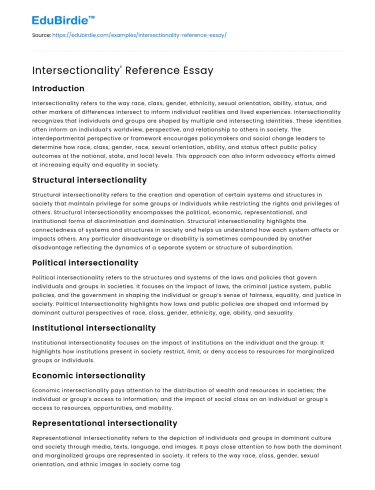Introduction
Intersectionality refers to the way race, class, gender, ethnicity, sexual orientation, ability, status, and other markers of differences intersect to inform individual realities and lived experiences. Intersectionality recognizes that individuals and groups are shaped by multiple and intersecting identities. These identities often inform an individual’s worldview, perspective, and relationship to others in society. The interdepartmental perspective or framework encourages policymakers and social change leaders to determine how race, class, gender, race, sexual orientation, ability, and status affect public policy outcomes at the national, state, and local levels. This approach can also inform advocacy efforts aimed at increasing equity and equality in society.
Structural intersectionality
Structural intersectionality refers to the creation and operation of certain systems and structures in society that maintain privilege for some groups or individuals while restricting the rights and privileges of others. Structural intersectionality encompasses the political, economic, representational, and institutional forms of discrimination and domination. Structural intersectionality highlights the connectedness of systems and structures in society and helps us understand how each system affects or impacts others. Any particular disadvantage or disability is sometimes compounded by another disadvantage reflecting the dynamics of a separate system or structure of subordination.
Save your time!
We can take care of your essay
- Proper editing and formatting
- Free revision, title page, and bibliography
- Flexible prices and money-back guarantee
Political intersectionality
Political intersectionality refers to the structures and systems of the laws and policies that govern individuals and groups in societies. It focuses on the impact of laws, the criminal justice system, public policies, and the government in shaping the individual or group’s sense of fairness, equality, and justice in society. Political Intersectionality highlights how laws and public policies are shaped and informed by dominant cultural perspectives of race, class, gender, ethnicity, age, ability, and sexuality.
Institutional intersectionality
Institutional intersectionality focuses on the impact of institutions on the individual and the group. It highlights how institutions present in society restrict, limit, or deny access to resources for marginalized groups or individuals.
Economic intersectionality
Economic intersectionality pays attention to the distribution of wealth and resources in societies; the individual or group’s access to information; and the impact of social class on an individual or group’s access to resources, opportunities, and mobility.
Representational intersectionality
Representational intersectionality refers to the depiction of individuals and groups in dominant culture and society through media, texts, language, and images. It pays close attention to how both the dominant and marginalized groups are represented in society. It refers to the way race, class, gender, sexual orientation, and ethnic images in society come together to create unique and specific narratives that shape and inform policies, laws, and institutions.






 Stuck on your essay?
Stuck on your essay?

